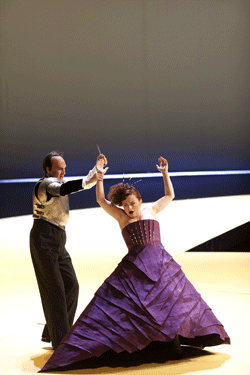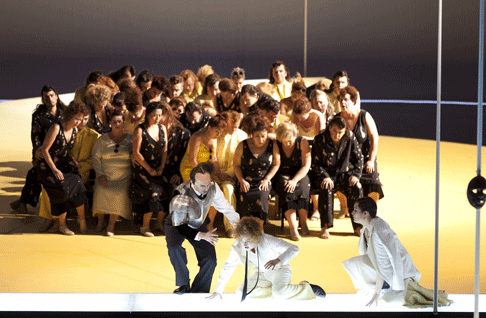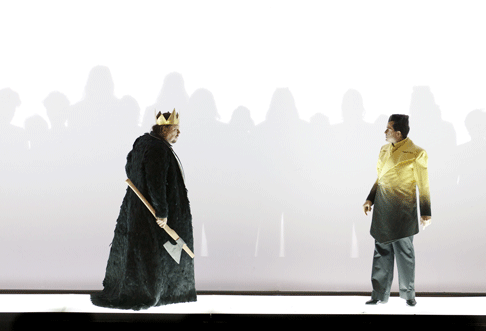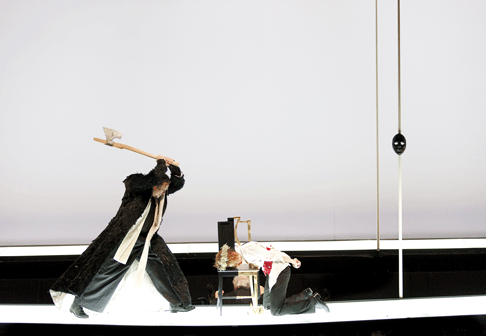13 Dec 2011
Amsterdam’s Adventurous Idomeneo
Straight to the point: Netherlands Opera has mounted as luminous and emotionally engaging an Idomeneo as is imaginable.

Straight to the point: Netherlands Opera has mounted as luminous and emotionally engaging an Idomeneo as is imaginable.
It is difficult to adequately describe the stunning imagery that designer Karl-Ernst Herrmann has put on display with his vivid sets, costumes, and lights (for all I know, he designed the program and swept the stage as well). All of the technical elements embody a profound depth of spirit, are supremely informative, and visually engaging. His colossal floor plan puts a four-foot wide illuminated white pentagonal walkway around the orchestra and right up to the edge of the parterre, and adjoins to it at curtain-line a massive upstage golden-hued beach “peninsula” which narrows as it recedes, and is on a hydraulic that can tilt it towards us quite steeply when so desired. A lone, Arp-inspired rock far upstage seems to be awaiting a mermaid.
 Edgaras Montvidas as Arbace and Susan Gritton as Elettra
Edgaras Montvidas as Arbace and Susan Gritton as Elettra
The sides and top of the proscenium are defined by a large dove-grey “box” which is initially enclosed by a similar panel that covers the entire proscenium opening. This is used to magical effect as a shadow screen to intensify any number of key downstage moments with appropriate moving images, from very small to very large. Surprisingly, the entire massive panel was hinged at the top so its bottom could swing away from us and upward to disappear into the loft, not only revealing the expanse of sand upstage, but also creating ominous lighting effects as the shadow crosses the playing space like a guillotine blade.
Mr. Herrmann has accessorized the space with mysterious poles, each bearing a ritualistic symbol atop, at once suggesting Crete, the origins of dramatic performance itself, and an uncanny timelessness. Carrying out that primitive theme, artful masks for the chorus are judiciously deployed, sometimes worn, sometimes carried aloft by hand, sometimes held aloft atop poles. His costumes are as character-defining as you are likely to see in many a year of opera-going. Just look at the chorus (singing with gusto under Martin Wright’s tutelage) in one scene arrayed in a courtly set of butter-cup yellow double-breasted suits and gowns, in another barefoot and dressed down in generic and timeless black peasant wear, in yet another appearing like a bygone era’s stereotypical tourists.
 Edgaras Montvidas as Arbace, Stéphanie d’Oustrac Idamante, Judith van Wanroij as Ilia and Koor van De Nederlandse Opera
Edgaras Montvidas as Arbace, Stéphanie d’Oustrac Idamante, Judith van Wanroij as Ilia and Koor van De Nederlandse Opera
Overall, Herrmann the Costumer favors a baggy, loose fitting silhouette, almost suggesting children playing grown-ups. Idomeneo is in a generous white suit with a stray piece of shoulder armor, swaddled one time in a white felt cape and another in a consuming, weighty fur. And, yes he wears the standard issue, spiky European opera “crown.” Idamanate’s look seems inspired by a white sailor uniform, augmented by an unfettered vest and black tie. Neptune is in a mix and match of green pants, overcoat, and laurel wreath, part seaweed, part Emerald City. And best, Elettra is a diva assoluta, with a sort of violet/burgundy strapless push-up bodice top (decorated with vertical black-lacquered boning) and skirt of overlaid fabric that flares out like a funnel. Matching pumps, jacket and hat complete the fashionable persona. The hair design was no less masterful with quirky sweeps of tresses that rivaled a hood ornament on a Chrysler.
His lighting was no less affecting, with its cunning use of shadow play, and its color palette that ranged from stark white, to moody blue, to dusty orange, to vivid yellow. The diffuse sun projection was at times blood red, at others milky white, and during the raging storm, eclipsed by a brooding black disc. The lightening effect was truly unsettling, perfectly enhancing the panicked scattering of rag-clad choristers. The end of Act I was punctuated by a startling’ coup de theatre’ as the waning musical effects decrescendo’d to their last whimper when — BANG! — three giant prongs of Neptune’s trident came thrusting up violently from the stage floor. The audience was snapped to attention as one. So many exciting design choices, but then, what of the work of Herrmann the Director?
In tandem with his wife Ursel, Ehepaar Herrmann have crafted a fluid, constantly evolving series of stage pictures and plot development that are a joy to behold and too numerous to celebrate here. In addition to telling the story with serious dramatic purpose, they have managed to infuse some genuine wit and theatricality into the evening with the lurking appearances of a sometimes aggressive, sometimes bemused Nettuno. One common thread is having the sea-god continue to offer Idomeneo an ax with which to execute Idamante. However, his first entrance has him poking his head up over the ramp from the orchestra pit. Later, during a light hearted moment, he reappears there, places a platter with a cooked fish on the stage, and proceeds to filet and eat it!
 Michael Schade as Idomeneo and Dietmar Kerschbaum as Gran sacerdote di Nettuno
Michael Schade as Idomeneo and Dietmar Kerschbaum as Gran sacerdote di Nettuno
The Herrmann’s have done exemplary work with the movement and uses of the industrious chorus. One memorable effect saw the front panel raise to reveal a massive black monolith center of the ‘beach.’ It was only after Idomeneo grabbed (what turned out to be) a piece of the black cloth and pulled away the covering that we realized the monolith was the shoulder-to-shoulder chorus huddled beneath it. A caveat: while all of the action and confrontations were believable and while all of the arias were well internalized, the limitations of the traffic patterns on the ramp did provide challenges in variety of blocking, which were largely overcome. But none of this fruitful physicalization would count for anything had the musical side not matched it, and here Netherlands Opera really scored big.
In the treacherous title role, Michael Schade sang with his accustomed polish, his pleasing grainy tone sounding suave and responsive, and his florid passages secure and fleet. I have always found him rather reserved, even stiff, with his stage deportment, but on this outing Mr. Schade displayed a passion and ferocity that made this a truly memorable role assumption. Matching him, Susan Gritton revealed herself to be an Elettra ne plus ultra. Her richly glamorous tone, interpretive savvy, flawless technique, and ample gleaming fire power dominated every scene she was in (as she must). On the basis of her recent Sesto in Paris and now her assured Idamante here, Stephanie d’Oustrac seems to be laying claim to becoming the pre-eminent Mozart Mezzo of the Moment. Her pliant, bewitching instrument has in its arsenal tremulous outbursts, plangent laments, and utter security with rip-snorting trip hammer coloratura. And she cuts a believable figure in these pants roles, blessedly free of clichéd ‘manly’ posturing.
 Michael Schade as Idomeneo and Stéphanie d’Oustrac as Idamante
Michael Schade as Idomeneo and Stéphanie d’Oustrac as Idamante
Having previously quite enjoyed Judith van Wanroij’s pure, silvery soprano in Monteverdi on this stage, I found my admiration well founded since she delivered a haunting, sympathetic Ilia. A pre-performance announcement in Dutch was made that I didn’t really follow, and when I asked about it at intermission I found that the singer performing Arbace was “indisposed.” I had actually already been mightily impressed by Edgardas Montvides for his vibrant tone and convincing delivery. What must he sound like when he is well!? All of the smaller roles were nicely essayed, particularly the delightfully warm soprano of diminutive Fang Fang Kong as a featured Cretan.
John Nelson led an idiomatic, highly detailed reading in the pit, eliciting vibrant colors and textures that made a potent case for Mozart’s opus. Noteworthy, too, were the wonderful contributions from Peter Lockwood with his aptly inventive playing of the continuo keyboard in tandem with the refined cello work from Herre-Jan Stergenga. When all the theatrical and musical planets align as they did with Netherlands Opera’s Idomeneo, you really are wholly drawn into an artistic experience that is, well, out of this world.
James Sohre